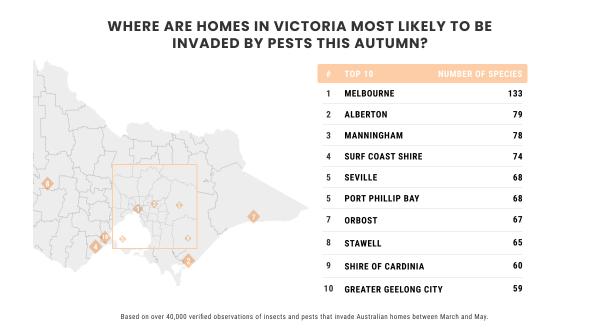Watch out Seville residents… New data by Cleanipedia found that homes in the Yarra Valley township are one of the most likely places across the state to be invaded by pests during Autumn.
The study identified 68 different species of pests in Seville, earning the rank of fifth among regions in the state. Areas ranked higher than Seville include the entire shires Manningham (78) and Surf Coast (74), the regional township of Alberton (79) and the city of Melbourne (133).
Clothes moths, carpet beetles, ants, termites, Portuguese millipedes, rats and mice are the most destructive types of home-invading pests in Australia during the autumn months.
Cleanipedia’s Alice Shaw-Beckett spoke about why it’s a problem when certain insects invade your home.
“Some insects get their nutrients from sugar and protein-rich natural fibres like cotton and linen, and animal-based ones such as leather, wool, and fur,” she said.
“Others are more attracted to the food stains and bodily fluids they come across on clothing. Sometimes it’s not an adult insect that’s munching on your jumper but their larvae, hatched from sometimes hundreds of eggs. When insects eat their way through or lay eggs on your clothes, they cause damage by leaving holes, weakened fabric, and waste products like urine, faeces, and empty larvae casings.
“Clothes-loving insects don’t just stop there – they’ll happily eat their way through all sorts of fabric in the home, including carpets, curtains, and furniture. Creepy-crawlies with a taste for starch (like silverfish and firebrats) will chomp away at wallpaper glue and plaster, as well as the paper in books, photographs, and newspapers.
“Animal-based products aren’t safe either, with glues (like those used for bookbinding), carpet underlay, and feather cushions providing a tasty meal for the likes of carpet beetles. Wooden structures in the home are at risk from termite and carpenter ant invasion, costing homeowners hundreds or thousands of rands to remove colonies and fix structural damage caused by hollowed-out beams and weakened frames.“
Ms Shaw-Beckett shared how to prevent insects from invading your home.
“Insects often get into your home through gaps in the walls and entry points like windows, vents, and pipes. Inspect your home for cracks and crevices and make sure to seal them to prevent more bugs from coming in.
“You can either seal the door by installing a nylon sturdy steel or use a door sweep. When it comes to windows, make sure that you always use screens if you open them to prevent insects from invading your home. Cleaning your home regularly minimises the risk of hungry insects looking for your leftover food. Make sure to mop up any spills and wipe down surfaces to prevent an insect invasion, and keep your bins sealed until you can empty them. Don’t let them overflow.
“Keep your opened food in sealed containers or put them in the fridge to ward off bugs like ants and beetles. You can never go wrong with a cleaning routine: make sure to vacuum your carpets and rugs and disinfect surfaces regularly. Dampness and wet areas in the house can attract insects like cockroaches, so watch out for leaking pipes.
“When it comes to any form of insect infestation, you will want to get rid of them as soon as possible … Blocking their entrances is the best place to start. Food is usually the main reason insects invade our homes, so storing food securely can solve the problem. Maintaining a clean kitchen will also get rid of insects; you can do this by simply using dishwashing liquid and warm water on surfaces, as well as adding the mixture to a spray bottle to target areas where insects are getting in.“
Cleanipedia analysed the data of more than 400,000 pest observations from biodiversity database, iNaturalist to find out the most commonly reported pests across Australia that are known to cause damage to clothes, fabric and surfaces and structures of homes.
For more information about Cleanipedia visit: https://www.cleanipedia.com/za/insect-invaders.html







